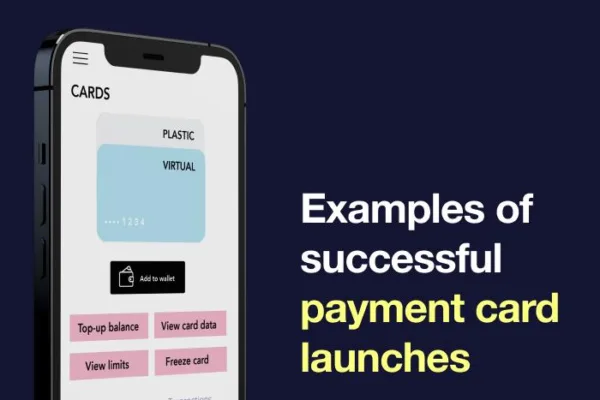The shift in the ways of consuming drives embedded payments

As consumption becomes more service-oriented, the companies who can offer a seamless end-to-end customer experience have the edge over others. Embedded cards enhance the customer experience, make payments safer, and provide opportunities for highly tailored, truly value-adding loyalty programmes.
Earlier this year, I predicted that the concept of embedded payments will take new leaps ahead that we didn’t see two or three years ago. Indeed, we are now seeing new embedded payment products and applications emerging everywhere.
Embedded payments means that the payment process is seamlessly integrated into the service instead of being a separate function. Read more about what embedded payments are and how you can take the first steps.
The rise of embedded payments is enabled by the major leaps in IT infrastructure that COVID-19 forced. The same infrastructure that enables widely distributed and affordable telecommunications is also the foundation on which embedded payments are built.
But it is the change in consumer behaviour that drives the revolution.
The popularity of embedded payments explodes as the ways of consuming change
In the age of platform economy and sharing economy, we are seeing a trend where people are moving from buying goods to consuming services.
For instance, in the traditional way of consuming, people regularly buy new clothes or glasses and dispose of the old ones in one way or another. Now we see emerging service models where people pay a subscription fee and get a set of clothes or glasses that matches their needs and taste to be used for a period of time. The goods are then collected by the service provider, and a new set is delivered.
In a market like this, embedding payments into the service flow can offer a competitive advantage in many ways:
- Better customer experience means higher use rate and better retention.
- Safer payments means less incidents, happier users, and a stronger brand.
- Value-adding loyalty and cashback programmes mean bigger purchases and more loyal customers.
- Better control over transaction costs and added income through interchange fees mean cost efficiency.
Inspiring examples from e-commerce and mobility
The ease of online shopping is the mission of a Nordic customer of ours. That’s why they needed to make payments effortless.
This startup brings a huge number of online shops under one roof. The service allows consumers to collect their desired products from whichever store is the cheapest, or the service provider does the shopping for them altogether. Then the customers can pay for the items sourced from several shops in a single transaction with a one-time-use card.
Outside of retail, mobility is a great example of the verticals that now focus on creating a seamless customer experience through embedded payments. Mobility companies and cities are figuring out ways to embed easy-to-use payment methods into their ticketing systems while optimising costs.
BLOG: Payments provide a major opportunity for cost optimisation in mobility services.
Add value through customer insight and tailored loyalty programmes
People are only willing to add another app to their phone or another card to their wallet if they feel they are getting something in return. You need to be able to communicate a clear reason for them to add your payment method.
- Your customers need to feel that adding the card will provide them value in the long term.
- Your customers need the process of adding the card and paying with it to be effortless and safe.
To build a truly relevant and value-adding payment method for your customers, you need to know what they appreciate in your service. What makes them feel special and well-served? What makes them come back for more? And that existing value you can then enhance with embedded payment methods and loyalty programmes.
Embedded cards will actually help you to make your service even more relevant for your customers. When you own a bigger chunk of the customer journey and purchase process, you also get access to a larger pool of payment and transaction data. This data provides you with customer insight that you can harness for further developing your service.
Great digital customer experience boils down to the number of clicks
For the modern customer, a seamless and effortless customer experience basically means that they can buy the thing they want in as few clicks as possible. At worst, a glitch in the process might mean that a customer who had already decided to buy and maybe even had items in the cart leaves before finalising the transaction.
Embedded payments is all about making life easier for the everyday customer, whether they are buying as a consumer or a business customer.
Denise Johansson, Co-CEO and Co-Founder at Enfuce
When embedding payments into a service flow, make sure you use all the tools and features available to keep the clicks and steps to a minimum. An app can open with facial recognition instead of having to type in a code. A form can use autofill instead of manually filling in information. Authentication can be made simple so that the user doesn’t have to go through strong authentication every time.
Frictionless user experience is one major reason why closed loop cards are a prevalent trend in embedded payments right now.
Denise Johansson, Co-CEO and Co-Founder at Enfuce
Closed loop solutions have the upper hand in user-friendliness and number of clicks over open banking applications, for instance. We will see more close loop networks being created wherever it adds value to the user of the service. With closed loop networks, companies can provide even faster account to account transactions.
Tokenisation and easy card management make payments safe
The safer the users feel using the card, the more they will use it. Security of payments also contributes to brand. And of course, less fraud incidents means less costs dealing with them.
Embedded cards provide more compliance and protection to how people use their money. In many subscription services, the users give their payment information to the provider and have their account charged regularly. This leaves the account vulnerable to misuse and fraud.
With the right payment card product, you can offer your customers a tool for managing their finances. When they are in control of the card through an app, for instance, they feel safe using the card.
While keeping the payments safe, an embedded card can also offer choices for payment methods. Tokenisation keeps card details protected and enables the use of digital wallets, for instance.
BLOG: How to turn embedded payments into next level customer experience.
BLOG: How mobility players can benefit from embedding payments into their app.



